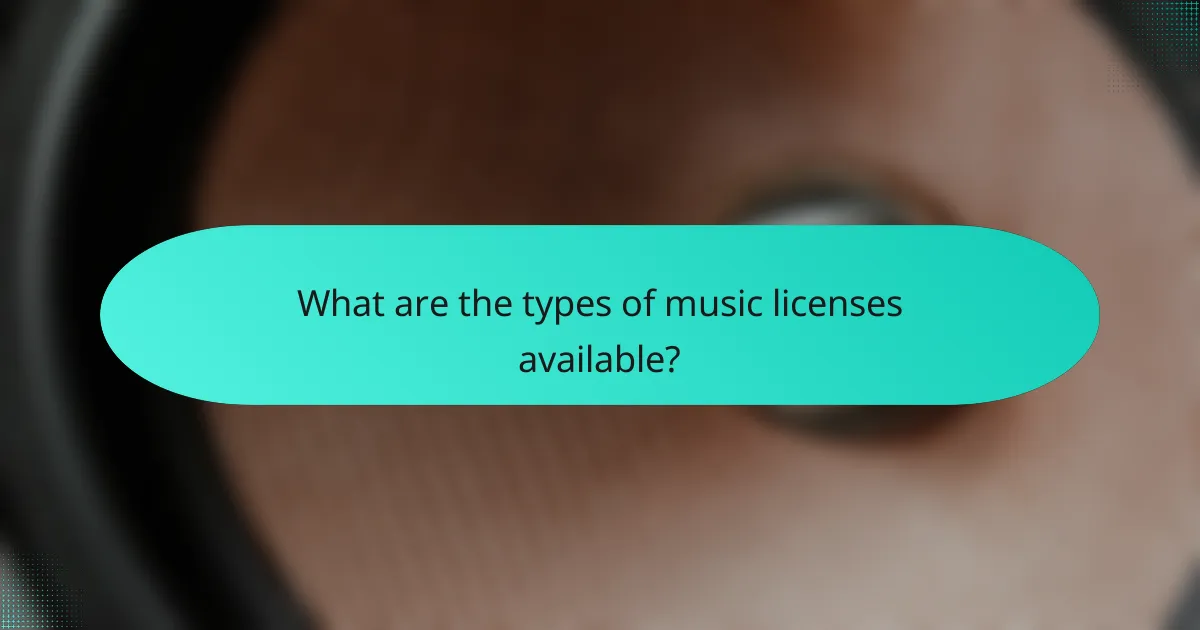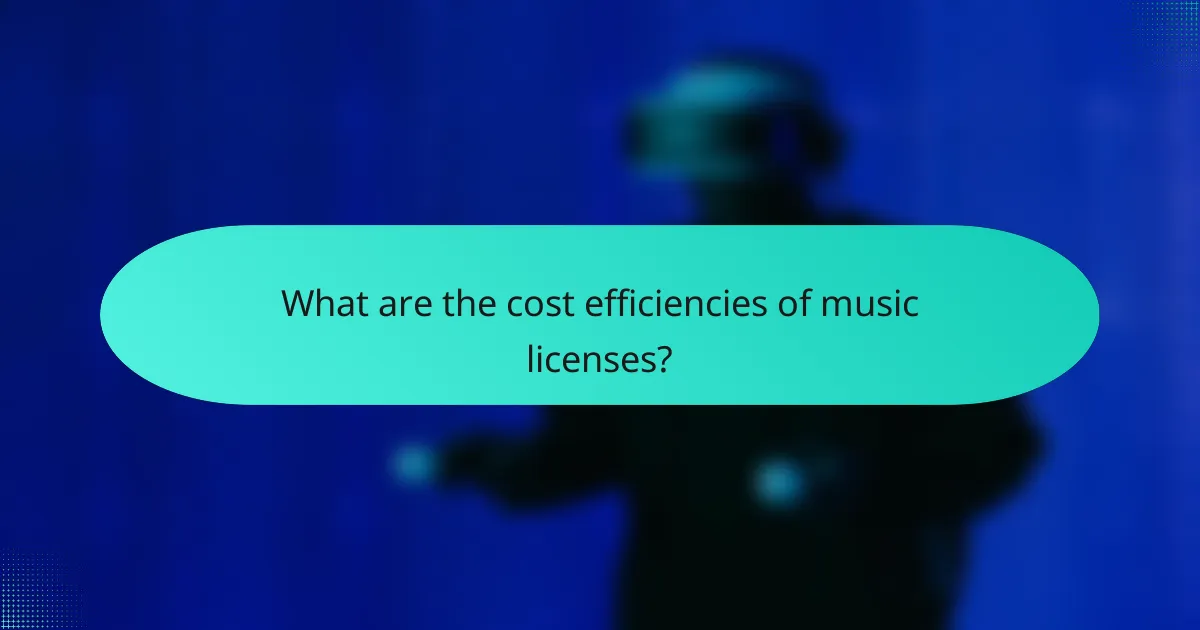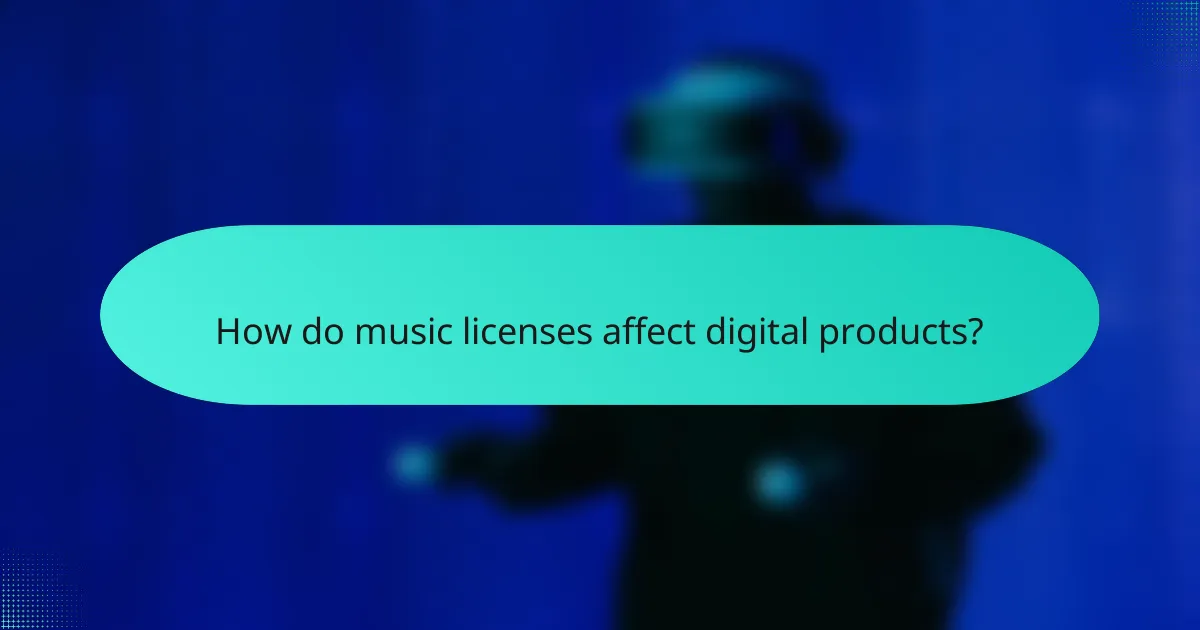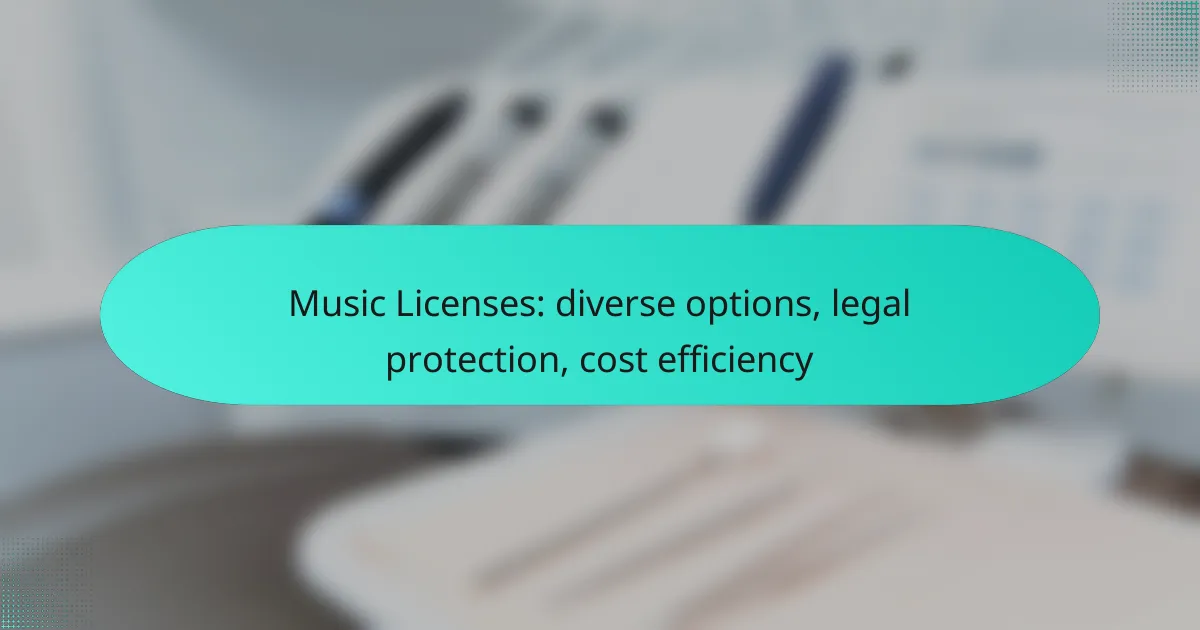Music licenses are essential tools that provide legal protection for both creators and users, allowing for the compliant use of copyrighted music in various projects. By understanding the diverse options available, individuals and businesses can achieve cost efficiency while ensuring that artists are fairly compensated for their work.

What are the types of music licenses available?
There are several types of music licenses that cater to different uses, each providing legal protection for creators and users. Understanding these licenses helps ensure compliance and can lead to cost efficiency when using music in various projects.
Synchronization licenses
Synchronization licenses are required when music is paired with visual media, such as films, TV shows, or advertisements. This type of license grants the right to synchronize a specific piece of music with visual content.
Costs for synchronization licenses can vary widely based on the popularity of the song and the scope of its use, ranging from hundreds to thousands of dollars. Always negotiate terms to clarify usage rights and duration.
Master use licenses
A master use license is needed to use a specific recording of a song, typically when the original recording is being used in a project. This license is separate from the synchronization license and covers the actual sound recording.
When negotiating a master use license, consider factors such as the artist’s fame and the intended distribution of the project. Fees can be substantial, often reflecting the recording’s commercial value.
Performance licenses
Performance licenses are necessary for playing music publicly, whether live or through recordings. These licenses are often managed by performance rights organizations (PROs) that collect fees on behalf of artists.
Costs for performance licenses depend on the venue size and type of event. For example, small venues may pay a few hundred dollars annually, while larger venues could incur thousands. Always check with local PROs for specific rates and requirements.
Mechanical licenses
Mechanical licenses are required for reproducing and distributing music, such as when creating CDs or digital downloads. This license ensures that songwriters and publishers receive royalties for their work.
The cost of mechanical licenses is typically calculated per copy sold, often around 9.1 cents per song in the U.S. for physical formats. Be sure to secure these licenses before production to avoid legal issues.
Creative Commons licenses
Creative Commons licenses allow artists to share their music while retaining certain rights. These licenses come in various forms, enabling users to know what they can and cannot do with the music.
Using music under Creative Commons can be cost-effective, as many tracks are available for free or at a low cost. However, always check the specific license terms to ensure compliance with attribution and usage restrictions.

How do music licenses provide legal protection?
Music licenses offer legal protection by granting rights to use copyrighted music while ensuring that creators are compensated. They define how, where, and when music can be used, thus safeguarding the interests of both artists and users.
Copyright protection
Copyright protection is the foundation of music licensing, as it secures the rights of creators over their original works. When a music license is obtained, it confirms that the user has permission to use the music, which helps prevent unauthorized use and potential infringement claims.
For example, a licensing agreement might specify that a song can be used in a film, but not for commercial purposes without additional fees. This clarity helps both parties understand their rights and responsibilities.
Enforcement of rights
Enforcement of rights is crucial for maintaining the integrity of music licenses. When a license is violated, the copyright holder can take legal action to enforce their rights, which may include seeking damages or an injunction against further use of the music.
Having a clear licensing agreement simplifies the enforcement process, as it outlines the terms of use and the consequences of violations. This can deter potential infringers who may otherwise assume they can use music without permission.
Liability reduction
Liability reduction is a significant benefit of obtaining music licenses, as it limits the legal risks associated with using copyrighted material. By securing a license, users can avoid costly lawsuits and penalties that may arise from unauthorized use.
For instance, businesses using music in advertisements without a license may face hefty fines or legal fees. A proper license mitigates this risk, providing peace of mind and allowing for creative freedom without fear of legal repercussions.

What are the cost efficiencies of music licenses?
Music licenses can offer significant cost efficiencies by providing access to a wide range of music at a lower overall expense. By understanding different licensing options, businesses and creators can minimize costs while ensuring legal protection for their projects.
Bulk licensing options
Bulk licensing allows users to obtain rights for multiple tracks or a library of music at a discounted rate. This is particularly beneficial for businesses that require extensive music use, such as radio stations or video production companies. By purchasing licenses in bulk, costs can be reduced by as much as 30-50% compared to individual track licensing.
When considering bulk licenses, evaluate the specific needs of your project to ensure the selected package covers all necessary tracks and usage rights. Always check the terms to confirm that the license allows for the intended applications, such as commercial use or public performance.
Negotiated rates
Negotiated rates involve discussions between the licensee and the rights holder to arrive at a mutually beneficial price. This approach can lead to lower costs, especially for long-term projects or when licensing high-demand tracks. It’s advisable to approach negotiations with a clear understanding of your budget and the value the music brings to your project.
To effectively negotiate, gather information on standard licensing fees and be prepared to present your case for a lower rate. Highlight factors such as the potential for future collaborations or promotional opportunities that could benefit the rights holder.
Royalty-free alternatives
Royalty-free music licenses allow users to pay a one-time fee for unlimited use of a track without ongoing royalties. This option is often more cost-effective for creators on a budget, as it eliminates the need for recurring payments. Royalty-free music can be found through various online platforms, offering a wide range of genres and styles.
However, it’s essential to read the terms of royalty-free licenses carefully, as some may have restrictions on commercial use or require attribution. Consider the specific needs of your project and whether the available tracks meet your quality and style requirements before committing to a royalty-free option.

What factors should be considered when choosing a music license?
When selecting a music license, consider the intended use, duration of use, and any geographic restrictions. These factors will help ensure that you choose a license that meets your needs while providing legal protection and cost efficiency.
Intended use
The intended use of the music significantly influences the type of license you need. For example, if you plan to use the music in a commercial context, such as advertisements or films, you may require a more comprehensive license compared to personal use, like background music for a home video.
Be clear about whether the music will be used for public performances, broadcasting, or online streaming, as these uses often have different licensing requirements. Always check if the license covers the specific type of use you have in mind to avoid potential legal issues.
Duration of use
Duration of use refers to how long you intend to utilize the music. Some licenses are granted for a limited time, while others may be perpetual, allowing indefinite use. If your project is temporary, a short-term license might suffice, but for ongoing projects, a longer-term license could be more cost-effective.
Consider the renewal process and any associated fees for licenses that expire. Understanding the duration helps in budgeting and planning your project effectively.
Geographic restrictions
Geographic restrictions determine where you can legally use the licensed music. Some licenses are valid only in specific countries or regions, which can impact your project if it has an international audience. Always verify if the license allows for global distribution or is limited to certain areas.
If your project will reach audiences in multiple countries, look for licenses that provide broader geographic coverage to avoid potential copyright infringements. This is particularly important for online content that may be accessed worldwide.

How do music licenses affect digital products?
Music licenses are crucial for digital products as they ensure legal use of music while protecting creators’ rights. They define how music can be used, whether in apps, streaming services, or content creation, impacting both compliance and cost efficiency.
Integration with apps
When integrating music into apps, obtaining the right licenses is essential to avoid legal issues. Developers must consider whether they need synchronization licenses for background music or performance licenses for interactive features. Failing to secure these can lead to costly penalties or app removal.
For example, using a popular song in a mobile game may require a different license than using royalty-free music. Budgeting for these licenses is critical, as costs can vary widely based on the artist’s popularity and the intended use.
Streaming services compliance
Streaming services must adhere to strict licensing agreements to legally distribute music. This includes securing mechanical licenses for reproducing songs and performance licenses for public playback. Non-compliance can result in fines and service shutdowns.
Services like Spotify and Apple Music typically negotiate blanket licenses, allowing them to stream a vast library of music. However, smaller platforms may need to negotiate individual agreements, which can be time-consuming and expensive.
Content creation regulations
Content creators, such as YouTubers and podcasters, must understand music licensing to avoid copyright strikes. Using licensed music without permission can lead to content removal or channel demonetization. It’s advisable to use royalty-free music or obtain licenses from reputable sources.
Many platforms offer subscription services for licensed music, providing access to a library for a monthly fee. This can be a cost-effective solution for creators looking to enhance their content legally while avoiding potential legal complications.
